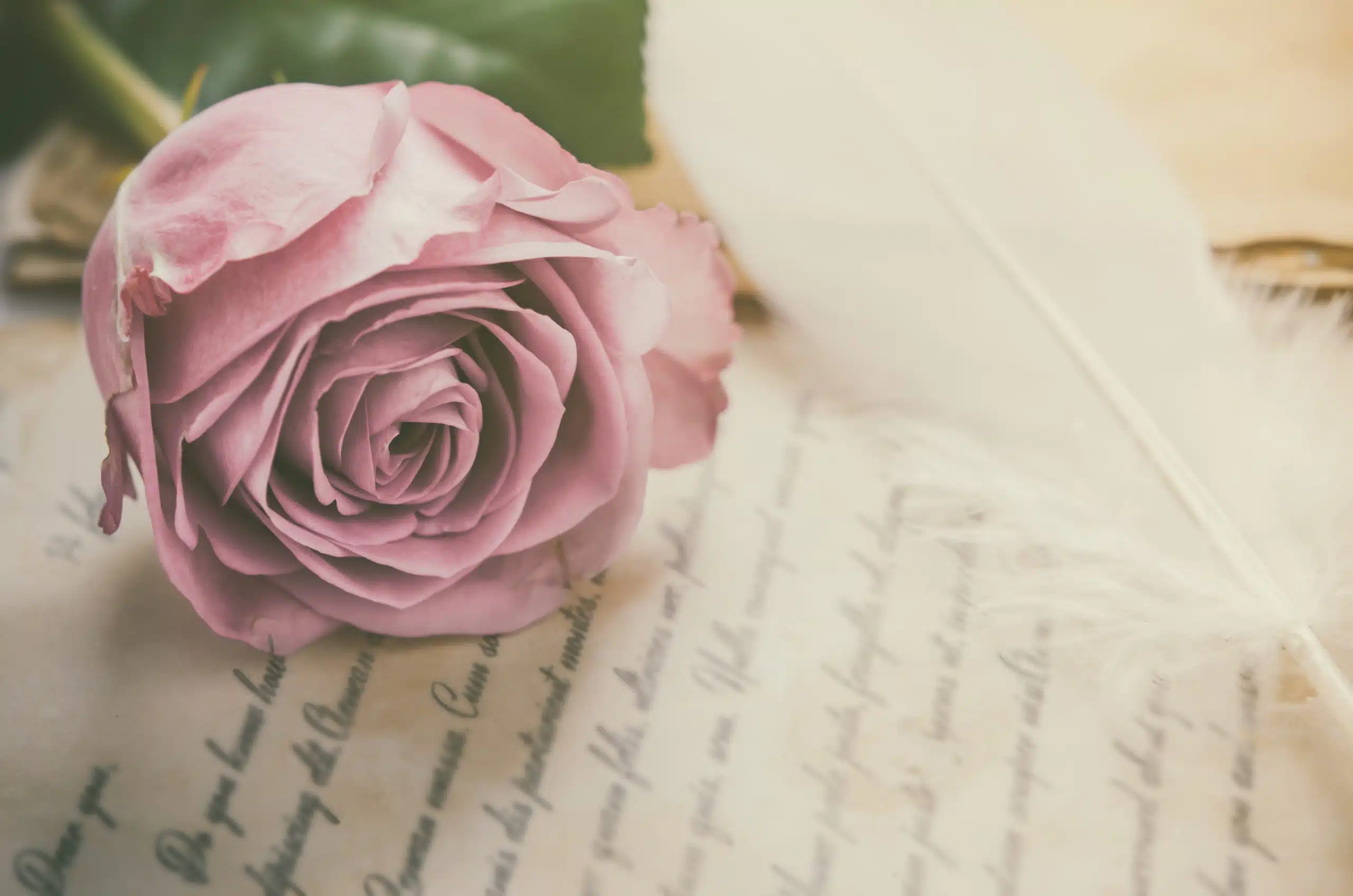Here’s what the Sestina poetry form is:
A sestina is a very specific verse form of French origin, consisting of six stanzas with six unrhymed lines each, usually concluded by an envoi with three lines.
Sestinas originated with the lyric poets (troubadour poets) of Southern France.
So if you want to learn all about the Sestina poetry type, then you’ve come to the right place.
Keep reading!
- Rimas Dissolutas Poetry Form: Elevate Your Mood
- Rime Couée Poetry Form: Rhyme Your Heart
- Descort Poetry Form: Unearth Fresh Perspectives
- Chanso Poetry Form: Strike Your Creative Chord

Forms of Poetry: The Sestina

The sestina is a complicated poem comprised of six sestets (six-line stanzas), usually followed by a three-line conclusion called an envoi that traces its roots to France.
Unlike many forms, the sestina was not applauded for its ability to capture a certain feeling or range of topics, but chiefly for its complexity.
It was intentionally created to represent a level of difficulty that only talented poets could aspire to and the form actually has many critics, even in the modern day.
Basic Properties of Sestina

| Rhyme Structure | Yes |
| Meter | Optional |
| Origin | French |
| Popularity | Unexpectedly revived in the late 19th and early 20th centuries |
| Theme | Varies |
How Are Sestinas Structured?

Sestinas are unique in that they are preoccupied not with end rhymes but with end words.
The words that end each line are repeated several times throughout, ultimately resulting in a structure that requires either memorization, written notes, or an understanding of the strange pattern by which these end sounds fall into place.
We will quickly go over the hard way to remember the structure, then the easy way.
The first six lines each have a different end sound.
So if we mark it as end words, then they are simply ABCDEF.
But then the endings are rearranged in accordance with the seemingly arbitrary sequence of 615243, where each number represents where the line originally was.
So the end word of the sixth line becomes the first, the end sound of the first line becomes the second, etc.
We ultimately end up with the sequence FAEBDC for the second stanza then.
This process is repeated with each new stanza, scrambling the order of the end words into six permutations based on this exact same transformation each time.
This is, of course, a ridiculous way to try to remember the structure, though.

An easier way is to look at this sequence: ABCDEF FAEBDC CFDABE ECBFAD DEACFB BDFCEA
The above sequence represents the first thirty-six lines of the sestina.
Just copy and paste it.
Yes, seriously.
Keeping the form written down somewhere is far easier, so why not?
No one would judge a mathematician for using a calculator, so you shouldn’t feel like you’re cheating if you want to do this the easy way.
The last three lines are where things get interesting.
This is where we typically run across the envoi which, in a sestina at least, is a tercet that finishes off the poem.
This stanza is unique in that three of the end words are buried within the lines instead of at the end.
The sequence also goes through one last permutation, so the final sequence is BE / DC / FA, where the first letter of each line represents the buried word and the second letter represents the actual end word.
If all that sounds needlessly confusing then congratulations, you picked up on the main point we need to make here.
Sestinas were purposely designed to be extremely difficult structures that can only be navigated with careful forethought.
Example of a Sestina

From A Miracle for Breakfast by Elizabeth Bishop
At six o’clock we were waiting for coffee,
waiting for coffee and the charitable crumb
that was going to be served from a certain balcony
–like kings of old, or like a miracle.
It was still dark. One foot of the sun
steadied itself on a long ripple in the river.
The first ferry of the day had just crossed the river.
It was so cold we hoped that the coffee
would be very hot, seeing that the sun
was not going to warm us; and that the crumb
would be a loaf each, buttered, by a miracle.
At seven a man stepped out on the balcony.
Above we have the beginning of Bishop’s famous sestina A Miracle for Breakfast.
Take special note of where the ending words fall in the stanzas since that’s the critical stumbling point for most poets.
As we expect from the structure above the end words follow as ABCDEF FAEBDC.
Simply replace the letters with the words and it all starts to make sense. Coffee (A), crumb (B), balcony (C), miracle (D), sun (E), river (F).
History of the Sestina

Most scholars attribute the invention of the sestina to Arnaut Daniel, a troubadour who lived in the 12th century.
Troubadours were essentially the popular lyric poets of the era, analogous to the common concept of a bard, recanting complex poems in the form of a song (often of romance) for the primary purpose of entertainment, especially in noble courts.
Daniel’s original name for the sestina, cledisat, loosely translates to “interlock” referencing the general structure of the form.
Daniel’s version of the sestina was ten syllables per line while the Italian poets favored eleven syllables per line.
It is commonly accepted now that a sestina has no set length per line as long as the number of lines matches up.
There is some minor disagreement about the invention of the sestina.
While the earliest known examples of sestina do seem to be from the troubadours, there are some scholars who believe that Daniel wrote the sestina as an evolution of a pre-existing form, rather than as something new.
Generally speaking though, the attribution to Arnaut Daniel holds firm amongst the majority.
While sestinas did see some moderate success initially, spreading to popular Italian poets like Dante and Petrarch, it was a mostly dead form for centuries until an unexpected revival in the late 19th and early 20th centuries, as poets took interest in bringing back old French forms.
The sestina as it was originally designed was meant to be a master form of the troubadours, meant only to be written by those with the skill to handle the form.
The meaning behind the sequence used for the end words has been lost to time and may have simply been meant as an arbitrary challenge for the troubadours.
Sestinas have been criticized by many scholars, usually because they feel that the arbitrary structure of the sestina does not lend itself to sincere expressions of emotion.
This is, however, a complaint that has pursued all of the formal poetry in recent decades, so whichever side you choose is purely a matter of personal preference.
Tips for Writing a Sestina

First and foremost, try to choose versatile end words that work in a variety of circumstances.
Vague words that can be reinterpreted over and over, such as love and hate, work especially well since their meaning can drastically change depending on the preceding line.
As a counter-example let’s say you ended a line with the word “clock.”
You now need to integrate a clock into your poem seven times over the course of the poem.
This is why words that are associated with concrete images can be difficult to work around in a sestina.
Try to avoid words that rhyme with each other, in general.
Sestinas are designed in such a way that a consistent rhyme scheme simply can’t exist.
So the end result would be a bit grating on the ears unless you were to choose six words that all end in the same sound, but at that point, you’re simply challenging yourself far more than necessary.
As for the lines themselves, any length is fine. English poems often love to fall into Iambic meter, regardless of form, but there is no hard-set rule that you need to add meter to a sestina of any kind.
Keeping the line lengths consistent is always best, though.
Remember that the original sestinas were meant to be sung with accompanying instruments, so while meter and consistency are optional they’re certainly welcome.
Lastly, make sure you have the pattern of the repetitions written out in front of you in some list or diagram that’s easily understandable for you.
If you would like to recalculate the order with each subsequent stanza then by all means do so, but you’ll find that most poets would rather jot down the final pattern somewhere.
It is the 21st century, after all.
Taking notes is one of the advantages of living in a mostly literate society.
As for the envoi, try to keep the buried words close to the middle of the line.
It would be a bit jarring if the repeated end words were at different points in each line since the reader/listener will have started to grow accustomed to the idea that there is a pattern by that point (even if it is a nearly indecipherable one).
Poet’s Note

I really, really wanted to find it suspicious that a whole poem form could just suddenly die for a few centuries.
That does seem to be what happened, though.
Comprehensive Collection of Poetry Forms: Craft Words Into Art

Dare to traverse the entire spectrum of poetic forms, from the commonplace to the extraordinary?
Venture from the quintessential Sonnet to the elusive Mistress Bradstreet stanza, right through to the daunting complexity of Cro Cumaisc Etir Casbairdni Ocus Lethrannaigecht.
For those with a zeal to encounter the full breadth of poetry’s forms, this invitation is yours.
Start exploring the vast universe of poetic ingenuity with our comprehensive array of poetry forms right now!
